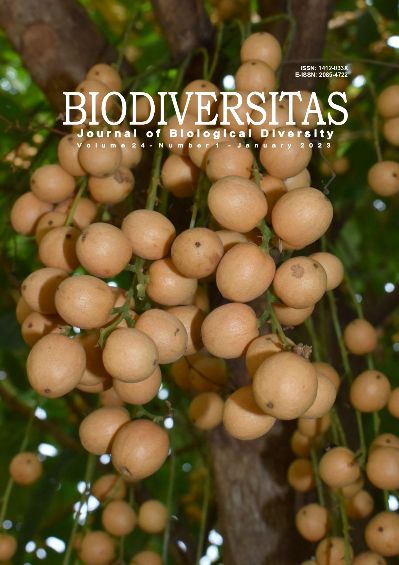The development of Spodoptera frugiperda (Lepidoptera: Noctuidae) on several varieties of maize
##plugins.themes.bootstrap3.article.main##
Abstract
Abstract. Nelly N, Hamid H, Lina EC, Yunisman, Yaherwandi, Putri YD. 2023. The development of Spodoptera frugiperda (Lepidoptera: Noctuidae) on Several varieties of maize. Biodiversitas 24: 523-530. Fall armyworm (FAW) or Spodoptera frugiperda (Lepidoptera: Noctuidae) is an invasive pest in Indonesia that cause damage to maize (Zea mays). Farmers for animal feed mainly cultivate several varieties of maize in West Sumatra, Indonesia. Therefore, it is necessary to test the resistance of maize varieties to fall armyworms planted by farmers. Therefore, this research aims to determine the resistance of several observed maize varieties based on their effects on the developmental time of S. frugiperda. The study was arranged in a Completely Randomized Design (CRD) with five treatments and five replications. The treatments for larvae feed consisted of five maize varieties: Sukmaraga, NK-212, Pioneer 21, Bonanza F1, and Secada F1. The development length from egg to adult and life parameters in the second generation were observed. Results of the study showed that the larval and pupal stages of S. frugiperda in the Sukmaraga variety had a longer development duration than the other four varieties, with the larval stage at 20.38 days and pupae at 11.26 days. In addition, the lowest pupae weight was found in the Sukmaraga variety. The maize varieties affect the length of the larval stage and the weight of the pupae and eggs produced. Based on these results, it can be concluded that Sukmaraga is a variety causing a more prolonged larval stage and lower pupae weight than other varieties. Furthermore, the eggs produced by the second-generation female S. frugiperda adult are fewer than in different varieties.
##plugins.themes.bootstrap3.article.details##
Most read articles by the same author(s)
- NOVRI NELLY, MY SYAHRAWATI, HASMIANDY HAMID, Abundance of corn planthopper (Stenocranus pacificus) (Hemiptera: Delphacidae) and the potential natural enemies in West Sumatra, Indonesia , Biodiversitas Journal of Biological Diversity: Vol. 18 No. 2 (2017)
- NOVRI NELLY, MY SYAHRAWATI, HASMIANDY HAMID, TRIMURTI HABAZAR, DWI NASRI GUSNIA, Diversity and characterization of entomopathogenic fungi from rhizosphere of maize plants as potential biological control agents , Biodiversitas Journal of Biological Diversity: Vol. 20 No. 5 (2019)
- YULMIRA YANTI, WARNITA WARNITA, REFLIN REFLIN, HASMIANDY HAMID, Short Communication: Development of selected PGPR consortium to control Ralstonia syzygii subsp. indonesiensis and promote the growth of tomatoYanti Y, Warnita, Reflin. 2018. Short Communication: Development of selected PGPR consortium to control Ralstoni , Biodiversitas Journal of Biological Diversity: Vol. 19 No. 6 (2018)
- ENIE TAURUSLINA AMARULLAH, TRIZELIA TRIZELIA, YAHERWANDI YAHERWANDI, HASMIANDY HAMID, Diversity of plant species in paddy ecosystem in West Sumatra, Indonesia , Biodiversitas Journal of Biological Diversity: Vol. 18 No. 3 (2017)
- Novri Nelly, Eka Candra Lina, Hasmiandy Hamid, Yunisman Yunisman, Distribution and genetic diversity of Spodoptera frugiperda J. E. Smith (Noctuidae: Lepidoptera) on maize in West Sumatra, Indonesia , Biodiversitas Journal of Biological Diversity: Vol. 22 No. 5 (2021)
- NOVRI NELLY, UJANG KHAIRUL, ADE YULIA PUTRI, HASMIANDI HAMID, MY SYAHRAWATI , Isolation and selection of maize plants rhizobacteria with the potential of entomopathogens against Spodoptera litura (Lepidoptera: Noctuidae) , Biodiversitas Journal of Biological Diversity: Vol. 21 No. 2 (2020)
- NOVRI NELLY, HASMIANDY HAMID, EKA CANDRA LINA, YUNISMAN, HIDRAYANI, DWI MONICA WIDYA SARI, Several local food plants with the potential as hosts for Spodoptera frugiperda (Lepidoptera: Noctuidae) , Biodiversitas Journal of Biological Diversity: Vol. 23 No. 3 (2022)
- NOVRI NELLY, RUSDI RUSLI, YAHERWANDI YAHERWANDI, FENI YUSMARIKA, Diversity of parasitoid Lepidopterans larvae on Brassicaceae in West Sumatra , Biodiversitas Journal of Biological Diversity: Vol. 11 No. 2 (2010)
- MY SYAHRAWATI, NOVRI NELLY, HASMIANDY HAMID, SISKA EFENDI, Short Communication: Abundance of corn planthopper (Stenocranus pacificus Kirkaldy 1907, Hemiptera: Delphacidae) on five new corn varieties , Biodiversitas Journal of Biological Diversity: Vol. 19 No. 3 (2018)
- IRFAN SULIANSYAH, SILVIA PERMATA SARI, NOVRI NELLY, HASMIANDY HAMID, Arthropods community on maize plantation in West Pasaman, West Sumatra, Indonesia , Biodiversitas Journal of Biological Diversity: Vol. 23 No. 6 (2022)

